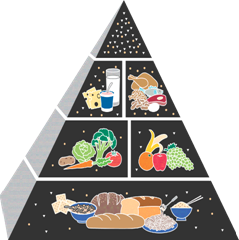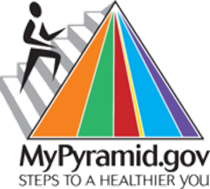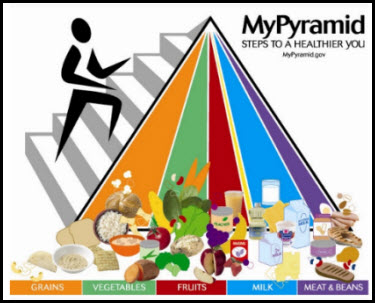MyPlate
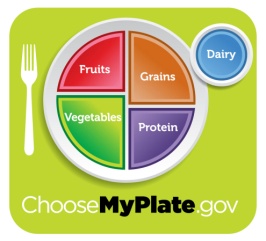
Unit Overview
In the next two units, you will be learning about the MyPlate Food Guidance System. Based upon the 2011 Dietary Guidelines, the United States Department of Agriculture (USDA) has launched the MyPlate Food Guidance System. MyPlate, released in June 2011, is an update of the MyPyramid. It provided web-based interactive and print materials for consumers and professionals. The new icon stresses activity and a proper mix of the different food groups. The pyramid is now called MyPlate because it is about healthy lifestyle choices and how these need to be personalized depending on the individual.
In this unit, you will look at the Orange/Grain group, the Green/Vegetable group, the Red/Fruit group, and the Blue/Milk and Cheese group. In the next unit, you will explore the Yellow/Oil group, the Purple/Meat and Beans group.
Out with the Old -
In with the New
____________________________________________
|
The New MyPlate 2011 |
|
What are the Differences?
The old logo emphasizes physical activity by showing a person climbing
steps on the side of the pyramid. MyPyramid
was colored with vertical bands that represent different food groups. The old logo MyPyramid is also
intentionally simpler than the food guide pyramid. Several USDA studies indicated that consumers
widely misunderstood the original design. The food guide pyramid gave
recommendations measured in "serving sizes", which some people found
confusing. MyPyramid gave its recommendations in cups, ounces, and other
measures that may be easier to understand.
The Food Guide Pyramid gave a single set of specific
recommendations for all people. In contrast, MyPyramid had 12 sets of
possible recommendations, with the appropriate guide for an individual selected
based on sex, age group, and activity level.
 Goodbye, pyramid. Hello, MyPlate. The Food Guide Pyramid was the model for healthy
eating in the United States. As of June
2, 2011 MyPlate has
replaced the MyPyramid image as the government’s primary food
group symbol as an easy-to-understand visual
cue to help consumers adopt healthy eating habits consistent with the 2010
Dietary Guidelines for Americans.
Goodbye, pyramid. Hello, MyPlate. The Food Guide Pyramid was the model for healthy
eating in the United States. As of June
2, 2011 MyPlate has
replaced the MyPyramid image as the government’s primary food
group symbol as an easy-to-understand visual
cue to help consumers adopt healthy eating habits consistent with the 2010
Dietary Guidelines for Americans.
MyPlate is based on suggestions from the 2010
Dietary Guidelines for Americans from the United States Department of Agriculture
(USDA) and the U.S. Department of Health and Human Services. Dietary Guidelines
recommendations traditionally have been intended for healthy Americans ages 2
years and older. However, Dietary Guidelines for Americans, 2010 was
released at a time of rising concern about the health of the American population.
Poor diet and physical inactivity are the most important factors contributing
to an epidemic of overweight and obesity affecting men, women, and children in
all segments of our society. Even in the absence of overweight, poor diet and
physical inactivity are associated with major causes of morbidity and
mortality in the United States. Therefore, the Dietary Guidelines for
Americans, 2010 is intended for Americans ages 2 years and older, including
those at increased risk of chronic disease. The Dietary Guidelines aim to educate Americans on the
importance of nutrition, lifestyle choices, and exercise.
The 2010 Dietary Guidelines for
Americans form the basis of the federal government’s nutrition education
programs, federal nutrition assistance programs, and dietary advice provided by
health and nutrition professionals.
The Guidelines messages include:
Balance
Calories
• Enjoy your
food, but eat less.
• Avoid
oversized portions.
Foods to
Increase
• Make half
your plate fruits and vegetables.
• Switch to
fat-free or low-fat (1%) milk.
• Make at least
half your grains whole grains
Foods to
Reduce
• Compare
sodium (salt) in foods like soup, bread, and frozen meals, and choose foods
with lower numbers.
• Drink water
instead of sugary drinks.
MyPlate, the plate shown on the copy of the web page above, is the new symbol that represents a system to help you determine how much of each food you should eat. MyPlate inspires us to build healthy meals with healthy choices. It encourages you to use an individual approach in determining amounts and kinds of foods to eat for optimum health.
The MyPyramid had six vertical stripes to represent the five food groups plus oils. MyPlate illustrates the five food groups using a familiar mealtime visual, a place setting.
|
|
|
|
MyPyramid |
MyPlate |
The MyPlate gives
you a visual of how your plate should be divided for healthy eating by filling
half your plate with fruits and vegetables. At a glance, it symbolizes
the importance of choosing a variety of foods from all food groups, focusing on
making half your plate fruits and vegetables.
The big message is that fruits and vegetables take up half the plate, with the vegetable portion being a little bigger than the fruit section.
And just like the pyramid where stripes were different widths, the plate has been divided so that the grain section is bigger than the protein section. Why? Because nutrition experts recommend you eat more vegetables than fruit and more grains than protein foods.
The divided plate also aims to discourage super-big portions, which can cause weight gain.
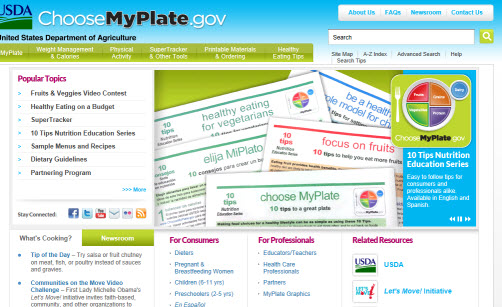
https://www.choosemyplate.gov/
A Guide to Healthy Living
The pyramid shows food groups as a series of differently-sized colored stripes.
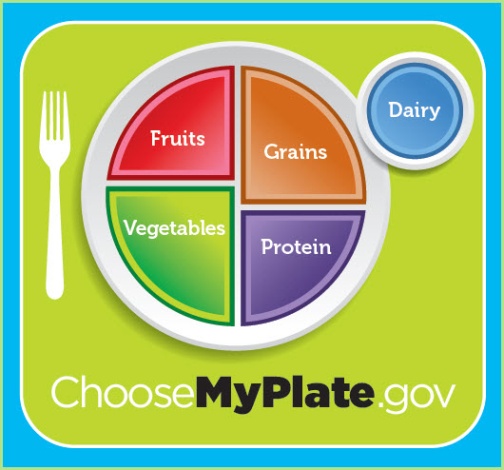
The stripes are different widths to show how much of a person's daily food intake should be made up of that food group. So the orange band is much wider than the yellow one because people need to eat a lot more grains than fats and oils. What we eat is tied to how much we exercise. Teens need to eat well to get the nutrients that help the body grow. But teens that are extremely active need additional food so they can fuel their activity levels in addition to their growth. And people who are less active need to eat less food so they can avoid gaining weight. We will discuss this more in the next unit.
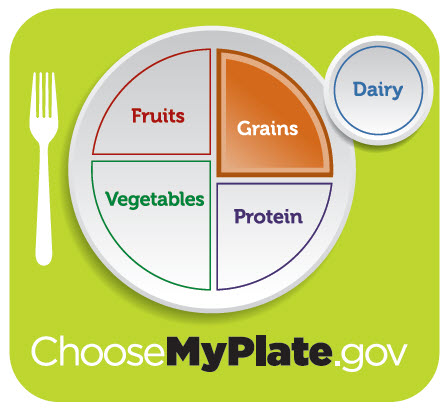
Which
Foods are in the Grain Group?
Grains are the
orange section on the upper right side of the plate. Grains are divided into 2
subgroups, Whole Grains and Refined Grains. Eat at least three ounces of whole
grain bread, cereal, crackers, rice or pasta. Select “whole grains.” One ounce
is usually one slice of bread, one cup of ready-to-eat cereal, or ½ cup of
cooked cereal, rice, or pasta. Grains can be divided into two groups. Whole
grains contain all three sections of the grain: the endosperm, the germ, and
the bran. Examples are whole-grain flour, brown rice, and oatmeal. Refined
grains go through the milling process where the bran and germ have been
removed. The milling process gives grain a finer texture and a longer on
shelf-life. At the same time, it removes some B vitamins, iron, and fiber.
Examples of refined grains are white flour, white rice, and white bread. Most
refined grains are enriched; B vitamins and iron are added after the milling
process is completed.
The amount of grains you need to eat depends on your age,
sex, and level of physical activity. The following link provides a chart with
the recommended daily amounts of grain needed.
Most Americans consume enough grains, but few are whole grains. At
least half of all the grains eaten should be whole grains.
Any food made from wheat, rice, oats, cornmeal, barley or another cereal grain is a grain product. Bread, pasta, oatmeal, breakfast cereals, tortillas, and grits are examples of grain products.
Grains are divided into 2 subgroups, whole grains and
refined grains.
|
Whole
Grains |
Refined
Grains |
|
Whole grains contain the entire grain kernel -- the bran, germ, and endosperm. Examples include:
|
Refined grains have been milled, a process that removes the bran and germ. This is done to give grains a finer texture and improve their shelf life, but it also removes dietary fiber, iron, and many B vitamins. Most refined grains are enriched. This means certain B vitamins (thiamin, riboflavin, niacin, folic acid) and iron are added back after processing. Fiber is not added back to enriched grains. Check the ingredient list on refined grain products to make sure. Some examples of refined grain products are:
|
|
Whole
Grains: brown rice whole wheat
cereal flakes
amaranth |
Refined
Grains: cornbread* spaghetti
corn flakes
white bread |
|
*Most of these products are made from refined grains. Some are made from whole grains. Check the ingredient list for the words “whole grain” or “whole wheat” to decide if they are made from a whole grain. Some foods are made from a mixture of whole and refined grains. Some grain products contain significant amounts of bran. Bran provides fiber, which is important for health. However, products with added bran or bran alone (e.g., oat bran) are not necessarily whole grain products. |
|
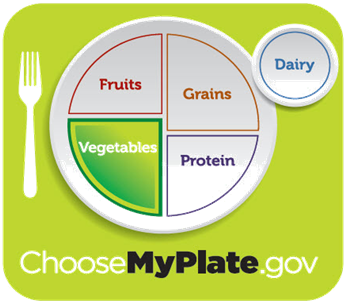
Which
Foods are in the Vegetable Group?
|
Vegetables The green section, lower left side of the plate, is vegetables. Eat more dark green, orange vegetables, dried beans and peas. Any vegetable or 100% vegetable juice counts as a member of the vegetable group. Vegetables may be raw or cooked; fresh, frozen, canned, or dried/dehydrated; and may be whole, cut-up, or mashed. Broccoli, spinach potatoes, corn, beans and lettuce are examples of the vegetable group. Vegetables are organized into 5 subgroups, based on their nutrient content. Some commonly eaten vegetables in each subgroup are: |
|
|
Dark Green
Vegetables
|
Dry Beans and Peas black beans |
|
Starchy
Vegetables corn |
Orange
Vegetables acorn squash |
|
Other Vegetables |
|
|
artichokes |
green or red peppers |
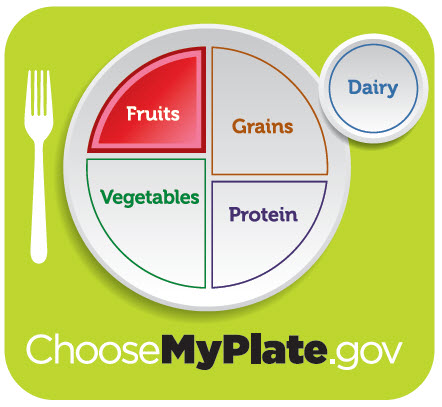
Which
Foods are in the Fruit Group?
The red section, upper left side of the plate, is
fruits. Be sure to eat fruit each day,
but do not drink large amounts of fruit juices. Fruits may be fresh, frozen,
canned, or dried. The fruit may be whole, sliced, cut into pieces, or pureed.
One cup of fruit or 100% fruit juice is a serving, while ½ cup of dried fruit
is a serving.
The amount of fruit you need to eat depends on age, sex, and level of physical
activity. Recommended daily amounts are shown in the chart.
|
Any fruit or 100% fruit juice counts as part of the fruit group. Fruits may be fresh, canned, frozen, or dried, and may be whole, cut-up, or pureed. Some commonly eaten fruits are raisins, oranges, apples, grapes and peaches. |
|
|
Berries: strawberries |
100% Fruit Juice: orange |
|
Melons: cantaloupe watermelon |
Mixed Fruits: fruit cocktail |
|
Common Fruits |
|
|
apples |
nectarines |
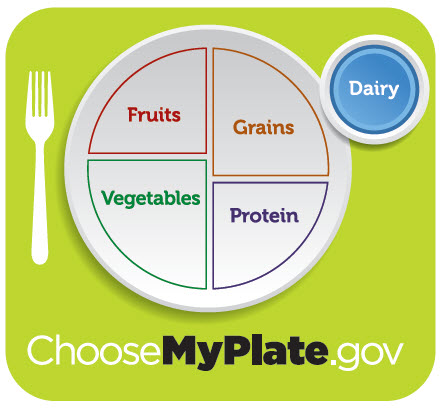
Which
Foods are in the Milk, Yogurt, and Cheese (Milk) Group?
|
All fluid milk products and many foods made from milk are considered part of this food group. Foods made from milk that retain their calcium content are part of this group, while foods made from milk that have little to no calcium, such as cream cheese, cream, and butter, are not. Most milk group choices should be fat-free or low-fat. Some commonly eaten choices in the milk, yogurt, and cheese group are ice cream, cheddar cheese, Swiss cheese, yogurt, milk and cottage cheese. Calcium-fortified soymilk (soy beverage) is also part of the Dairy Group. If you cannot eat dairy foods, choose other food sources that contain calcium. |
|
|
Milk all fluid milk: fat-free (skim) chocolate lactose reduced milks |
Cheese hard natural cheeses: cheddar soft cheeses ricotta processed cheeses American |
|
Milk-Based
Desserts puddings
made with milk |
Yogurt all yogurt fat-free |
